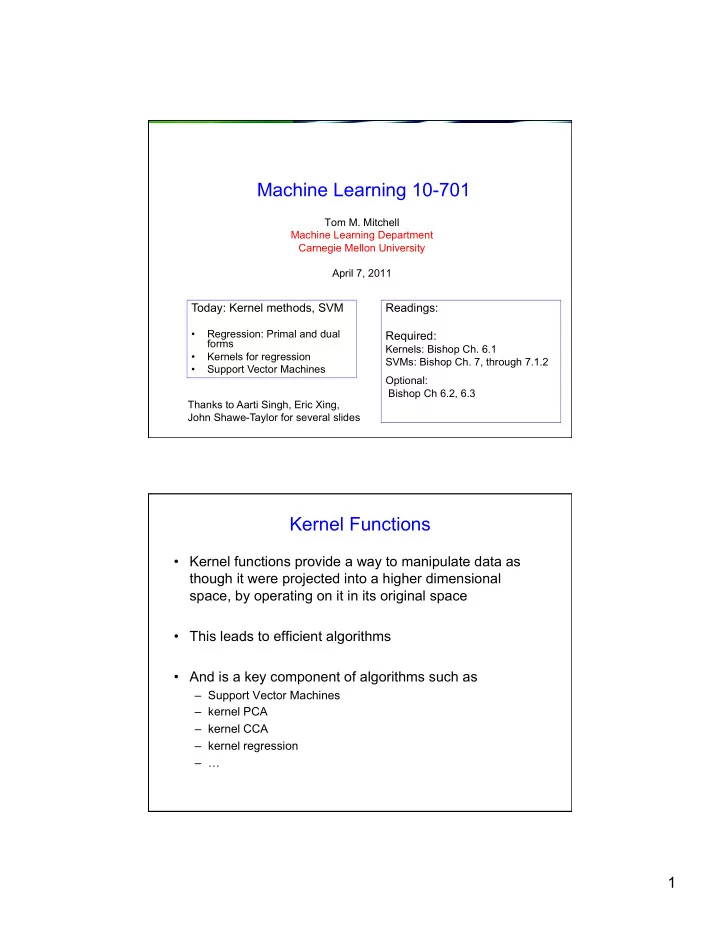

Machine Learning 10-701 Tom M. Mitchell Machine Learning Department Carnegie Mellon University April 7, 2011 Today: Kernel methods, SVM Readings: • Regression: Primal and dual Required: forms Kernels: Bishop Ch. 6.1 • Kernels for regression SVMs: Bishop Ch. 7, through 7.1.2 • Support Vector Machines Optional: Bishop Ch 6.2, 6.3 Thanks to Aarti Singh, Eric Xing, John Shawe-Taylor for several slides Kernel Functions • Kernel functions provide a way to manipulate data as though it were projected into a higher dimensional space, by operating on it in its original space • This leads to efficient algorithms • And is a key component of algorithms such as – Support Vector Machines – kernel PCA – kernel CCA – kernel regression – … 1
Linear Regression Wish to learn f: X Y, where X=<X 1 , … X n >, Y real-valued Learn where Linear Regression Wish to learn where Learn where here the l th row of X is the l th training example x T l and 2
Vectors, Data Points, Inner Products Consider where for any two vectors, their dot product (aka inner product) is equal to product of their lengths, times the cosine of angle between them. Linear Regression: Primal Form Learn where solve by taking derivative wrt w , setting to zero… so: 3
Aha! Learn where solution: But notice w lies in the space spanned by training examples (why?) Linear Regression: Dual Form Primal form: Learn Solution: Dual form: use fact that Learn Solution: 4
[slide from John Shawe-Taylor] [slide from John Shawe-Taylor] 5
[slide from John Shawe-Taylor] [slide from John Shawe-Taylor] 6
Kernel functions Original space Projected space (higher dimensional) Example: Quadratic Kernel Suppose we have data originally in 2D, but project it into 3D using this converts our original linear regression into quadratic regression! But we can use the following kernel function to calculate inner products in the projected 3D space, in terms of operations in the 2D space And use it to train and apply our regression function, never leaving 2D space 7
Implications of the “Kernel Trick” [slide from John Shawe-Taylor] Some Common Kernels • Polynomials of degree d • Polynomials of degree up to d • Gaussian/Radial kernels (polynomials of all orders – projected space has infinite dimension) • Sigmoid 8
Which Functions Can Be Kernels? • not all functions • for some definitions of k(x 1 ,x 2 ) there is no corresponding projection ϕ (x) • Nice theory on this, including how to construct new kernels from existing ones • Initially kernels were defined over data points in Euclidean space, but more recently over strings, over trees, over graphs, … • Some of this covered in 10-702 Kernels : Key Points • Many learning tasks are framed as optimization problems • Primal and Dual formulations of optimization problems • Dual version framed in terms of dot products between x’s • Kernel functions k(x,y) allow calculating dot products < Φ (x), Φ (y)> without bothering to project x into Φ (x) • Leads to major efficiencies, and ability to use very high dimensional (virtual) feature spaces 9
Kernel Based Classifiers Simple Kernel Based Classifier [slide from John Shawe-Taylor] 10
Linear classifiers – which line is better? 11
Pick the one with the largest margin! Parameterizing the decision boundary w T x + b > 0 w T x + b < 0 x + b = 0 T w Labels: 12
Parameterizing the decision boundary w T x + b > 0 w T x + b < 0 x + b = 0 T w Labels: Maximizing the margin Margin = Distance of closest examples from the decision line/ hyperplane w T x + b = a w T x + b = 0 w T x + b = -a margin = γ = a/ ‖ w ‖ γ γ 13
Maximizing the margin Margin = Distance of closest examples from the decision line/ hyperplane w T x + b = a w T x + b = 0 w T x + b = -a margin = γ = a/ ‖ w ‖ max γ = a/ ‖ w ‖ w , b γ γ s.t. ( w T x j + b ) y j ≥ a ∀ j Note: ‘a’ is arbitrary (can normalize equations by a) Support Vector Machine min w T w w , b w T x + b = a w T x + b = 0 w T x + b = -a s.t. ( w T x j + b ) y j ≥ 1 ∀ j Solve efficiently by quadratic programming (QP) – Well-studied solution γ γ algorithms Linear hyperplane defined by “support vectors” 14
Recommend
More recommend